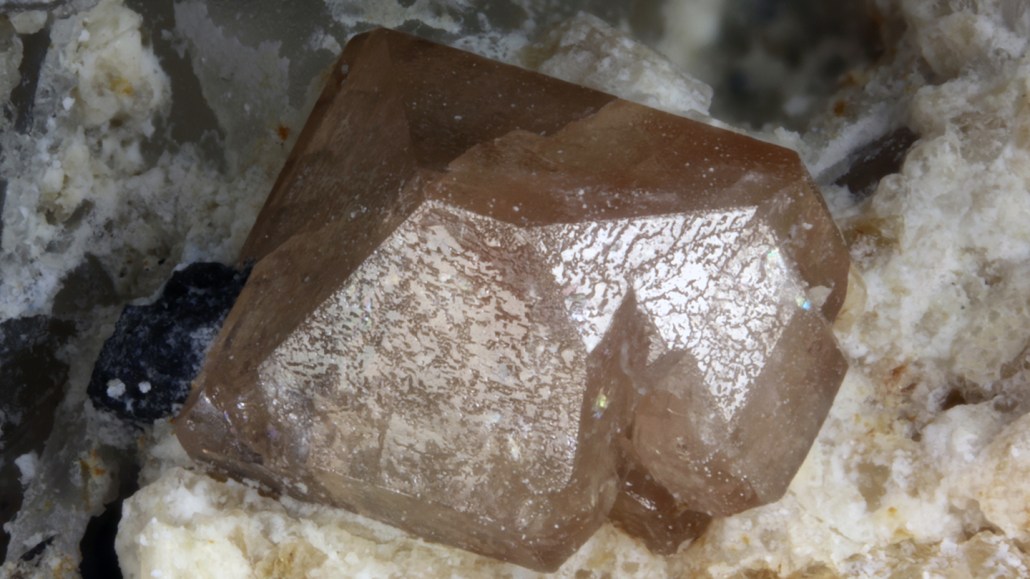Tiny gemstones show when Earth’s crust first started moving
Zircons indicate plate tectonics first began some 3.8 billion years ago

Zircons are hardy gemstones that can endure for eons. The crystal pictured here is from Italy. Scientists spotted a chemical change in 3.8-billion-year-old zircons from South Africa that suggests when plate tectonics first got underway.
Matteo Chinellato – ChinellatoPhoto/Photographer's Choice RF/Getty Images
Share this:
- Share via email (Opens in new window) Email
- Click to share on Facebook (Opens in new window) Facebook
- Click to share on X (Opens in new window) X
- Click to share on Pinterest (Opens in new window) Pinterest
- Click to share on Reddit (Opens in new window) Reddit
- Share to Google Classroom (Opens in new window) Google Classroom
- Click to print (Opens in new window) Print
By Nikk Ogasa
A thin layer of rock and dirt covers the Earth. Known as the crust, it may have begun moving roughly 3.8 billion years ago. That’s the finding of a new study.
Scientists settled on that date by looking at a type of ancient crystals — gemstones known as zircons. The zircons that formed nearly 4 billion years ago started to show chemical changes. They appeared somewhat different from earlier ones. Those changes now seem to reflect when chunks of Earth’s crust started to slide beneath one another. This crucial process is known as subduction. And those chunks that slide around? They’re known as “tectonic plates.”
Plate tectonics is the process of those plates pushing, shoving and diving beneath each other. Until plate tectonics got underway, early Earth may have been jacketed by a sleeping crust — much like the thin, rocky surface on Venus, say Nadja Drabon and her team. A geochemist, Drabon is someone who studies the chemistry of rocks. She works at Harvard University in Cambridge, Mass.
So when did Earth’s crust wake up and start moving?
For a long time, that was a big question. Scientists have only rarely seen hints of plate tectonics on other moons or planets. Drabon’s team that’s been trying to figure out when Earth’s crust had suddenly “become so special?”
Clues emerged in their study of some very old gems. In the April AGU Advances, they now piece together those clues to pinpoint the apparent origin of tectonics on Earth.
Why study zircons?
Earth is roughly 4.56 billion years old. What did its crust look like before those plates began moving? That’s been a subject of much debate. One reason why: That movement would have started billions of years ago. And few rocks can survive such a long span of rough-and-tumble crumpling of Earth’s crust. Zircons — a type of bright crystal — are among the few rocks that do hold up well despite such activity.
As zircons grow, they capture radioactive uranium. Geologists know this uranium decays into lead at a very predictable rate. That decay rate of uranium makes it relatively easy to estimate a zircon’s age. And that has shown that zircons can last billions of years.
Zircons also tend to keep lead out. So any lead within a zircon probably started as radioactive uranium — before it had decayed.
Zircons retain other clues, too, to the environment in which they form. That’s because they capture tiny amounts of nearby elements as they grow.
Most of the world’s zircons are at least 4 billion years old and have turned up at just a dozen locations. Many of these come from just one site in Australia. But Drabon and her colleagues have been looking at another source in South Africa: the Barberton Makhonjwa Mountains.
The team studied dozens of zircons from here that are between 4.15 and 4 billion years old. Thousands more are at least 3.3 billion years old. These crystals have now helped researchers learn about what Earth’s environment must have been like in between those dates. These gems point to what was happening when a time known as the Hadean Eon was ending and the next — the Archean Eon — was getting underway.
What the rocks showed
The new research focused on tiny traces of several elements in the old zircons. These included uranium, scandium, ytterbium, niobium and cerium. The scientists also looked for different forms of oxygen and hafnium.
That hafnium turned out to be a big part of the story. Before 3.8 billion years ago, most zircons contained a version of this element that matched up to a time when Earth’s crust was thin and stable.
The older zircons also contained traces of other elements that match what is found in zircons from the Hawaiian Islands. The volcanoes that created those islands formed when molten rock rose from Earth’s mantle and then hardened. (That process doesn’t require moving tectonic plates.)
But zircons that formed more recently than 3.8 billion years ago show no chemical evidence of that early crust. Many of these gems were very similar to the ones found today in places where two tectonic plates collide, with one plate diving below the other. (Remember, that’s called subduction).
That change in the chemical recipe of zircons now suggests a big shift occurred at or near 3.8 billion years ago, says Jennifer Kasbohm of Yale University in New Haven, Conn. Kasbohm was not involved in the study. But as a geochronologist (Gee-oh-kron-OLL-uh-gizt), she does study rocks to understand their age. And, she notes, “We really consider subduction to be essential for plate tectonics.”
Zircons from other places, such as Australia and India, also show similar elemental patterns, Drabon’s group reports. Combining that evidence with their research from South Africa now suggests that an early form of plate tectonics may have turned on across the planet roughly 3.8 billion years ago.
Drabon plans to continue looking for other minerals that were trapped inside the zircons when they formed. Any newfound hitchhiking bits in these ancient crystals could help scientists learn even more about Earth’s youth.







